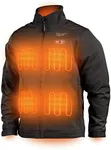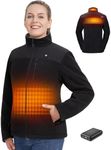Buying Guide for the Best Heated Jackets
Heated jackets are a great solution for staying warm in cold weather, whether you're working outdoors, enjoying winter sports, or just want extra comfort during chilly days. When choosing a heated jacket, it's important to look beyond just the heating feature and consider how the jacket fits your lifestyle, the climate you'll use it in, and your personal comfort preferences. Understanding the key specifications will help you find a jacket that keeps you warm, comfortable, and safe.Heating ZonesHeating zones refer to the specific areas of the jacket where the heating elements are placed, such as the chest, back, and sometimes the sleeves or collar. This is important because more zones can provide more even warmth, but may also use more battery power. Jackets with fewer zones may focus heat on the core, which is often enough for most people. If you get cold easily or want warmth in specific areas, look for a jacket with more heating zones. If you just need basic warmth, fewer zones may be sufficient.
Battery LifeBattery life tells you how long the jacket can provide heat on a single charge. This is crucial if you plan to be outside for long periods without access to charging. Battery life can range from a few hours to over ten hours, depending on the heat setting and battery size. Lower settings usually last longer, while higher settings use more power. Think about how long you'll need the heat—if you’re out all day, look for longer battery life or the option to swap batteries.
Heat SettingsHeat settings allow you to adjust the temperature of the jacket, usually with low, medium, and high options. This is important for comfort and battery management. More settings give you better control over your warmth and can help extend battery life by letting you use lower settings when possible. If you want flexibility for different weather conditions, choose a jacket with multiple heat settings.
Material and InsulationThe outer material and insulation affect how well the jacket keeps you warm even when the heating is off, as well as its durability and weather resistance. Materials like polyester or nylon are common for water and wind resistance, while added insulation can help trap heat. If you’ll be in wet or windy conditions, look for water-resistant and windproof materials. If you want a jacket that’s warm even without the heater, choose one with good insulation.
Fit and ComfortFit and comfort are about how the jacket feels when you wear it, including its weight, flexibility, and how it fits your body. A good fit ensures the heating elements stay close to your body for better warmth. Some jackets are slim and lightweight, while others are bulkier for extra insulation. Try to pick a fit that matches your activity—slimmer for active use, roomier for layering or casual wear.
Safety FeaturesSafety features include things like automatic shut-off, overheat protection, and safe battery enclosures. These are important to prevent accidents or discomfort. If you plan to use the jacket for long periods or in demanding conditions, make sure it has basic safety features to protect you from overheating or electrical issues.
Charging and Battery TypeThe type of battery and how it charges can affect convenience. Most heated jackets use rechargeable lithium-ion batteries, but charging times and compatibility can vary. Some batteries can also charge your phone or other devices. If you want to use your jacket frequently, look for quick-charging batteries or the ability to buy spares. If you travel, check if the charger is compatible with your region.
Care and MaintenanceCare and maintenance refer to how easy it is to clean and look after the jacket. Some heated jackets are machine washable after removing the battery, while others require hand washing. If you want a low-maintenance option, check the care instructions and make sure it fits your lifestyle.





![[2024 All-New] Heated Vest for Wome](https://images-proxy.bestreviews.guide/XrIHmvjMie4UR2Sum7MlscfTUHg=/0x150/https://m.media-amazon.com/images/I/41APmuVSTgL._AC_CX679_.jpg)





![[Upgraded Battery] ORORO Women's Heated Puffer Jacket with Battery, Heated Puffer Parka for Hiking Camping Outdoors (Black,M)](https://images-proxy.bestreviews.guide/t8UVSABm6ELjXIaaRTZxnAurNZY=/0x150/https://m.media-amazon.com/images/I/41-M6ImRI0L._AC_CX679_.jpg)




